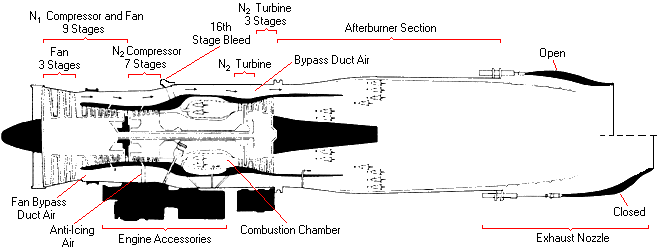Engine TF30-P-414A

Engine TF30-P-414A |
| This is the engine that is still operable in the F-14A, an engine that made a lot of trouble and caused some loss of life and aircraft. |
 |
| Todays F-14s are powered by two different engines (not two different engines in one F-14, but two types in the F-14 fleet), the old TF30 and the new and more reliable General Electric F110 (no cut-away drawing yet available). The new engine has increased power and enables the Tomcat to launch from a catapult without the use of afterburners and even allows to climb away after catapult launch when one engine is lost. The F110 was considered so reliable that it entered service even without clearance for afterburner take-offs! In 1981 an alternative engine was tested in the first F-14B, then the designation for a Grumman prototype (BuNo. 157986) with a pair of Pratt & Whitney F401-PW-400 engines. But after extensive tests with this engine technical difficulties occured and the engine was rejected. Today the F-14's two engine-variants can easily be distinguished when viewing their nozzles. Click on the thumbnails to view a larger photo. |
| TF30 Engine: | F110 Engine: | |
| Diameter Weight Rate of airflow Bypass ratio Max. Combustion chamber temperature Thrust Thrust with Afterburner Specific Fuelconsumption Specific Fuelconsumption with Afterburner | 1245 mm 1825 kg 118.0 kg/s 0.73 1590 K 68.0 kN 112.0 kN 68 kg/(kNh) 255 kg/(kNh) | 1180 mm 1740 kg 120.0 kg/s 0.85 1745 K 73.8 kN 124.5 kN 76 kg/(kNh) 201 kg/(kNh) |
| Note the specific fuel consumption for both engines with afterburner! If you read the numbers it is obvious why it is so important that the Tomcats (Bs & Ds) can launch from the carrier without the use of the fuel-eating afterburners. |
 |  |  |